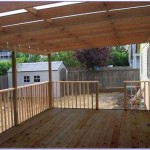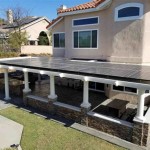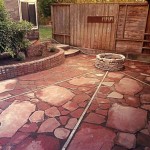How to Level a Concrete Patio Slab
Uneven concrete patio slabs are a common problem affecting both the aesthetics and functionality of outdoor living spaces. Causes range from soil settling and erosion to frost heave and tree root intrusion. Regardless of the origin, a sunken or tilted patio not only presents a tripping hazard but also can lead to water pooling, potentially damaging the patio structure and surrounding areas. Fortunately, several methods exist to address this issue, ranging from simple DIY fixes for minor imperfections to more involved professional solutions for significant settling.
Before embarking on a concrete leveling project, a thorough assessment of the damage is essential. This evaluation should include identifying the extent of the unevenness, determining the underlying cause, and considering the long-term implications. A clear understanding of these factors will guide the selection of the most appropriate leveling technique and ensure the longevity of the repair. Ignoring the root cause can lead to a recurrence of the problem, necessitating further repairs in the future. Furthermore, understanding the scope of the problem allows for accurate estimation of required materials and labor, a crucial factor for both DIY and professionally executed projects.
Safety is paramount throughout the entire leveling process. Appropriate personal protective equipment (PPE), including safety glasses, gloves, and respiratory protection, should be worn at all times. Power tools and heavy materials require careful handling to prevent injuries. When working with cementitious materials, adherence to manufacturer's instructions is crucial for safe and effective application. If unsure about any aspect of the process, consulting with a qualified professional is strongly advised.
Identifying the Problem and Choosing the Right Method
The first step in leveling a concrete patio slab is a careful inspection to determine the severity and extent of the problem. A level, straight edge, and measuring tape are indispensable tools for this task. Place the straight edge across the uneven sections of the patio and measure the gaps beneath. This will reveal the degree to which the slab is sunken or tilted. Mark the areas that require leveling for clear identification during the repair process. Observe the surrounding area for signs of erosion, poor drainage, or root encroachment, as these factors may contribute to the problem and require separate attention.
Several methods exist for leveling concrete patios, each suited to different degrees of unevenness and soil conditions. For minor dips and imperfections, a surface patching compound may suffice. This involves applying a thin layer of cementitious material to fill in the low spots and create a smooth, level surface. For more significant settling, mudjacking or slabjacking is a common technique. This process involves injecting a grout mixture beneath the slab to lift it back into position. Polyurethane foam injection is a more modern alternative to mudjacking, offering advantages in terms of weight, durability, and expansion control. Finally, for severely damaged or extensively sunken slabs, complete replacement may be the most practical option.
The choice of leveling method will depend on several factors, including the extent of the unevenness, the underlying soil conditions, the budget, and the availability of equipment and expertise. Surface patching is the least expensive and most straightforward option but is only suitable for minor imperfections. Mudjacking and polyurethane foam injection are more effective for significant settling but require specialized equipment and skills. Complete replacement is the most expensive and time-consuming option but ensures a long-lasting and structurally sound solution.
Surface Patching for Minor Imperfections
For small cracks, uneven joints, or minor dips in the patio surface, a patching compound can be used to create a smooth, level finish. This method is relatively simple and inexpensive, making it a popular choice for DIY homeowners. Before applying the patching compound, thoroughly clean the affected area. Remove any loose debris, dirt, or vegetation using a wire brush and pressure washer. A clean surface is essential for proper adhesion of the patching compound. If cracks are present, widen them slightly with a chisel to allow the patching compound to penetrate deeply. Thoroughly rinse the area and allow it to dry completely.
Select a high-quality concrete patching compound specifically designed for outdoor use. Follow the manufacturer's instructions for mixing the compound, ensuring a consistent and workable consistency. Apply the compound to the affected area using a trowel, pressing it firmly into the cracks and dips. Overfill the low spots slightly, as the compound will shrink slightly as it cures. Use the trowel to smooth the surface and blend it seamlessly with the surrounding concrete. For larger areas, a screed board can be used to ensure a level finish.
Once the patching compound has been applied, protect it from direct sunlight and extreme temperatures during the curing process. Cover the area with plastic sheeting or damp burlap to prevent rapid drying, which can lead to cracking. Allow the patching compound to cure for the amount of time specified by the manufacturer, typically 24 to 72 hours. After curing, the patched area can be sealed with a concrete sealer to protect it from moisture and stains. This sealant will protect the patch from weathering and increase its lifespan.
Mudjacking and Polyurethane Foam Injection
For significant settling, mudjacking or polyurethane foam injection offers a more robust solution. Both methods involve injecting a material beneath the slab to lift it back into position. Mudjacking utilizes a mixture of cement, soil, and water, while polyurethane foam injection uses a lightweight, expanding foam. These methods are generally performed by professionals who have the necessary equipment and experience.
The mudjacking process involves drilling small holes through the concrete slab. A slurry of mud is then pumped through these holes, filling the voids beneath the slab and gradually lifting it back to its original level. The technician will constantly monitor the slab's position and adjust the injection pressure to ensure a smooth and even lift. Once the slab is level, the holes are patched with concrete. Mudjacking is a cost-effective option, but the heavy weight of the mud can sometimes contribute to future settling.
Polyurethane foam injection offers several advantages over mudjacking. The foam is much lighter than mud, reducing the risk of future settling. It also expands rapidly, filling voids more effectively and providing greater lifting power. The foam is also hydrophobic, meaning it repels water and helps to prevent erosion. The injection process is similar to mudjacking, but the foam cures much faster, allowing the patio to be used sooner. While polyurethane foam injection is typically more expensive than mudjacking, its superior performance and durability often make it a worthwhile investment.
Both mudjacking and polyurethane foam injection require careful planning and execution. The technician must accurately assess the voids beneath the slab and determine the appropriate injection points. The injection pressure must be carefully controlled to prevent cracking or further damage to the concrete. A skilled technician can restore a sunken patio to its original level quickly and efficiently using either of these methods.
When choosing between mudjacking and polyurethane foam injection, consider the soil conditions, the severity of the settling, and the long-term performance requirements. In unstable soil, polyurethane foam injection may be the better choice due to its lighter weight and greater stability. For minor to moderate settling, mudjacking may be a more cost-effective option. Obtain quotes from multiple contractors and carefully evaluate their experience and qualifications before making a decision.
Before hiring a contractor, request references and check their licensing and insurance. A reputable contractor will provide a detailed assessment of the problem and a clear explanation of the proposed solution. They should also be able to answer any questions you have about the process and the associated costs. It is essential to have a written contract that outlines the scope of work, the materials to be used, the payment schedule, and the warranty terms.
Regardless of the chosen leveling method, addressing the underlying cause of the settling is crucial for preventing future problems. This may involve improving drainage, removing tree roots, or stabilizing the soil around the patio. Neglecting these issues will likely result in a recurrence of the problem, requiring further repairs in the future. A comprehensive approach that addresses both the symptom and the cause offers the best chance of a long-lasting solution.

Patio Lifting Leveling Repair Concrete Hero

Quikrete Building A Concrete Patio

Level And Stain A Concrete Porch Self Leveling

How To Level A Concrete Patio Homeserve Usa

How To Pour A Large Concrete Patio Slab With 3 Slope

How To Plan Pour Your Diy Concrete Patio Liberty Ready Mix

Diy Concrete Patio How To Pour A Slab Bob Vila

How To Prepare A Site For Concrete Base Forms And Rebar

How To Lay A Patio On Concrete Or Over Paving Marshalls

How To Pour A Concrete Slab Diy Family Handyman
Related Posts








